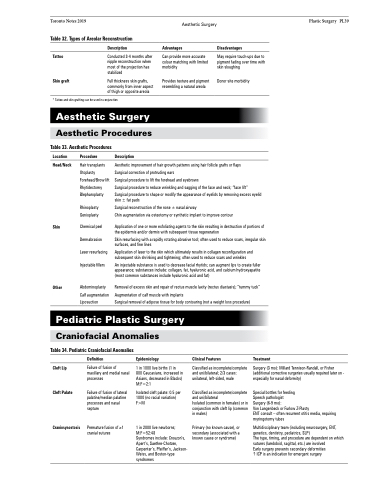Page 1161 - TNFlipTest
P. 1161
Toronto Notes 2019
Aesthetic Surgery
Plastic Surgery PL39
Table 32. Types of Areolar Reconstruction
Tattoo
Skin graft
Description
Conducted 3-4 months after nipple reconstruction when most of the projection has stabilized
Full thickness skin grafts, commonly from inner aspect of thigh or opposite areola
Advantages
Can provide more accurate colour matching with limited morbidity
Provides texture and pigment resembling a natural areola
Disadvantages
May require touch-ups due to pigment fading over time with skin sloughing
Donor site morbidity
* Tattoo and skin grafting can be used in conjunction
Aesthetic Surgery
Aesthetic Procedures
Table 33. Aesthetic Procedures
Location
Head/Neck
Skin
Other
Procedure
Hair transplants Otoplasty Forehead/Brow lift Rhytidectomy Blepharoplasty
Rhinoplasty Genioplasty
Chemical peel Dermabrasion Laser resurfacing Injectable fillers
Abdominoplasty Calf augmentation Liposuction
Description
Aesthetic improvement of hair growth patterns using hair follicle grafts or flaps
Surgical correction of protruding ears
Surgical procedure to lift the forehead and eyebrows
Surgical procedure to reduce wrinkling and sagging of the face and neck; “face lift”
Surgical procedure to shape or modify the appearance of eyelids by removing excess eyelid skin ± fat pads
Surgical reconstruction of the nose ± nasal airway
Chin augmentation via osteotomy or synthetic implant to improve contour
Application of one or more exfoliating agents to the skin resulting in destruction of portions of the epidermis and/or dermis with subsequent tissue regeneration
Skin resurfacing with a rapidly rotating abrasive tool; often used to reduce scars, irregular skin surfaces, and fine lines
Application of laser to the skin which ultimately results in collagen reconfiguration and subsequent skin shrinking and tightening; often used to reduce scars and wrinkles
An injectable substance is used to decrease facial rhytids; can augment lips to create fuller appearance; substances include: collagen, fat, hyaluronic acid, and calcium hydroxyapatite (most common substances include hyaluronic acid and fat)
Removal of excess skin and repair of rectus muscle laxity (rectus diastasis); “tummy tuck” Augmentation of calf muscle with implants
Surgical removal of adipose tissue for body contouring (not a weight loss procedure)
Pediatric Plastic Surgery
Craniofacial Anomalies
Table 34. Pediatric Craniofacial Anomalies
Cleft Lip
Cleft Palate
Craniosynostosis
Definition
Failure of fusion of maxillary and medial nasal processes
Failure of fusion of lateral palatine/median palatine processes and nasal septum
Premature fusion of ≥1 cranial sutures
Epidemiology
1 in 1000 live births (1 in 800 Caucasians, increased in Asians, decreased in Blacks) M:F=2:1
Isolated cleft palate: 0.5 per 1000 (no racial variation) F>M
1 in 2000 live newborns; M:F=52:48
Syndromes include: Crouzon’s, Apert’s, Saethre-Chotzen, Carpenter’s, Pfeiffer’s, Jackson- Weiss, and Boston-type syndromes
Clinical Features
Classified as incomplete/complete and uni/bilateral; 2/3 cases: unilateral, left-sided, male
Classified as incomplete/complete and uni/bilateral
Isolated (common in females) or in conjunction with cleft lip (common in males)
Primary (no known cause), or secondary (associated with a known cause or syndrome)
Treatment
Surgery (3 mo): Millard Tennison-Randall, or Fisher (additional corrective surgeries usually required later on - especially for nasal deformity)
Special bottles for feeding
Speech pathologist
Surgery (6-9 mo):
Von Langenbeck or Furlow Z-Plasty
ENT consult – often recurrent otitis media, requiring myringotomy tubes
Multidisciplinary team (including neurosurgery, ENT, genetics, dentistry, pediatrics, SLP)
The type, timing, and procedure are dependent on which sutures (lambdoid, sagittal, etc.) are involved
Early surgery prevents secondary deformities
h ICP is an indication for emergent surgery


